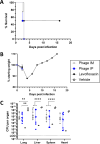A bacteriophage cocktail targeting Yersinia pestis provides strong post-exposure protection in a rat pneumonic plague model
- PMID: 39292000
- PMCID: PMC11537065
- DOI: 10.1128/spectrum.00942-24
A bacteriophage cocktail targeting Yersinia pestis provides strong post-exposure protection in a rat pneumonic plague model
Abstract
Yersinia pestis, one of the deadliest bacterial pathogens ever known, is responsible for three plague pandemics and several epidemics, with over 200 million deaths during recorded history. Due to high genomic plasticity, Y. pestis is amenable to genetic mutations as well as genetic engineering that can lead to the emergence or intentional development of pan-drug-resistant strains. Indeed, antibiotic-resistant strains (e.g., strains carrying multidrug-resistant or MDR plasmids) have been isolated in various countries and endemic areas. Thus, there is an urgent need to develop novel, safe, and effective treatment approaches for managing Y. pestis infections. This includes infections by antigenically distinct strains for which vaccines (none FDA approved yet) may not be effective and those that cannot be managed by currently available antibiotics. Lytic bacteriophages provide one such alternative approach. In this study, we examined post-exposure efficacy of a bacteriophage cocktail, YPP-401, to combat pneumonic plague caused by Y. pestis CO92. YPP-401 is a four-phage preparation effective against a panel of at least 68 genetically diverse Y. pestis strains. Using a pneumonic plague aerosol challenge model in gender-balanced Brown Norway rats, YPP-401 demonstrated ~88% protection when delivered 18 h post-exposure for each of two administration routes (i.e., intraperitoneal and intranasal) in a dose-dependent manner. Our studies provide proof-of-concept that YPP-401 could be an innovative, safe, and effective approach for managing Y. pestis infections, including those caused by naturally occurring or intentionally developed multidrug-resistant strains.IMPORTANCECurrently, there are no FDA-approved plague vaccines. Since antibiotic-resistant strains of Y. pestis have emerged or are being intentionally developed to be used as a biothreat agent, new treatment modalities are direly needed. Phage therapy provides a viable option against potentially antibiotic-resistant strains. Additionally, phages are nontoxic and have been approved by the FDA for use in the food industry. Our study provides the first evidence of the protective effect of a cocktail of four phages against pneumonic plague, the most severe form of disease. When treatment was initiated 18 h post infection by either the intranasal or intraperitoneal route in Brown Norway rats, up to 87.5% protection was observed. The phage cocktail had a minimal impact on a representative human microbiome panel, unlike antibiotics. This study provides strong proof-of-concept data for the further development of phage-based therapy to treat plague.
Keywords: Tier-1 select agent; Yersinia pestis; aerosol challenge; bacteriophage; biodefense; pneumonic plague; rat model; therapeutic.
Conflict of interest statement
The YPP-401 cocktail was developed by Intralytix, Inc. The following authors report conflicts of interest with respect to Intralytix, Inc.: A.S. (co-founder, employee, shareholder); J.A.S. (employee, shareholder); J.W. (employee, shareholder); and L.H. (employee).
Figures



Update of
-
A Bacteriophage Cocktail Targeting Yersinia pestis Provides Strong Post-Exposure Protection in a Rat Pneumonic Plague Model.bioRxiv [Preprint]. 2024 Jan 18:2024.01.17.576055. doi: 10.1101/2024.01.17.576055. bioRxiv. 2024. Update in: Microbiol Spectr. 2024 Nov 5;12(11):e0094224. doi: 10.1128/spectrum.00942-24. PMID: 38293171 Free PMC article. Updated. Preprint.
References
-
- McGovern TW, Friedlander AM. 1997. Plague, p 479–502. In Frederick R, Sidell MD, Ernest T, Takafuji MD (ed), Medical aspects of chemical and biological warfare. Office of The Surgeon General at TMM Publications, Borden Institute, Walter Reed Army Medical Center, Washington, DC.
MeSH terms
Grants and funding
LinkOut - more resources
Full Text Sources
Medical
Molecular Biology Databases

